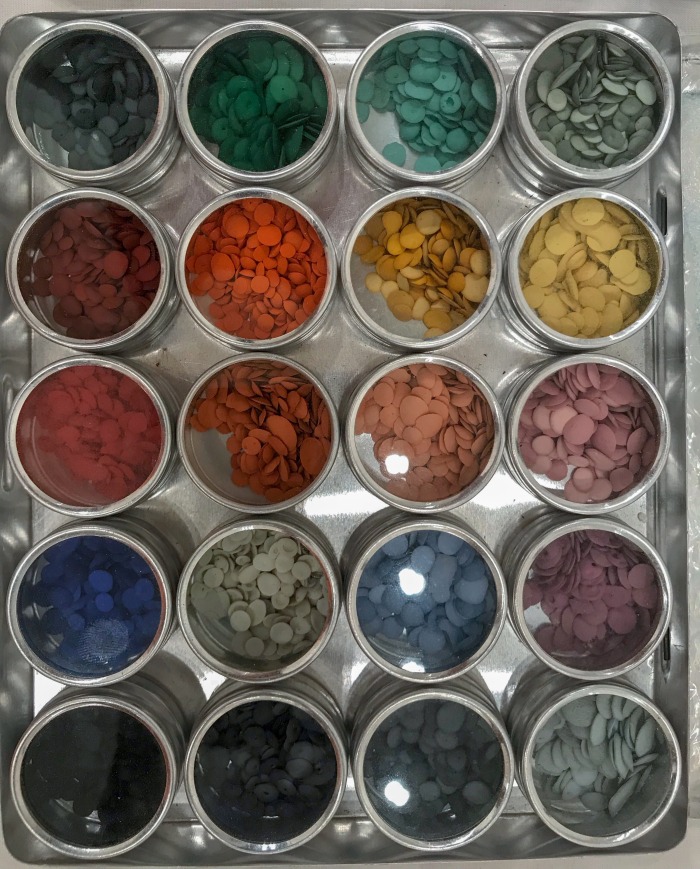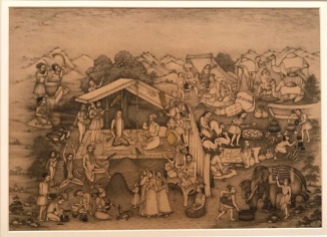I first came across Mahaveer Swami’s art at Narendra Bhawan Bikaner when I was exploring the hotel on my first evening there. In a narrow space, not unlike a gallery, I came across some exquisite framed works of art.
These were paintings with detailing like miniatures, but with a completely different colour palette — predominantly pastels, instead of the bright saturated colours usually identified with such paintings. A closer look also revealed quirky details in some of the paintings like two women using a computer or a man with a telephone, among others.
Intrigued by the art, I enquired about the artist at the hotel. “That is Mahaveer Swami ji, a Bikaneri artist”, was the reply. “He’s a National Award winner.”
“Is it possible to meet him?” I enquire.
“I’m sure that can be arranged,” comes the enigmatic reply.
The next day, when our group returns from one of our explorations of Bikaner, we found Mahaveer Swami and his son, Anuraag waiting for us. Over a brief interaction, Mahaveerji told us about the salient points of the Bikaner School of painting and how his work had retained the essence, but gave it a contemporary feel with a completely new colour palette. He had brought along some of his paintings, including one that he was currently working on — a series based on the Hanuman Chalisa — and some of paintings of women and everyday life, but with a twist. 🙂

As Mahaveerji and Anuaag took their leave, I asked them if it was possible to me to visit their studio. They were delighted with my request and invited me to visit them, and the next day I did just that. It was a wonderful visit and one that I cherish even today. It gave me the perfect opportunity to appreciate the legacy of the traditional Bikaner School of painting, and its contemporary form as practised by Mahaveerji. A 6th generation artist from a family of traditional miniaturists, Mahaveerji began his training with his father and grandfather. As Mahaveer ji me took me around his studio and showed me the ante-chamber where he painted, he said:
This is where my father and his father before him painted. It has about 300 years of continuous use as a studio, which we call saal.
Just listening to Mahaveerji say this gave me goose bumps. Entering the saal, which is a long narrow room, gave me the feeling of entering a sacred space. A space of creativity and one to be treated with veneration. I spent a very happy morning there going through Mahaveerji’s work, his library and his paint cupboard.

The paint cupboard is no ordinary cupboard; it is a cupboard that has all the ingredients to create masterpieces through the magic of an artist’s palette. The bottles are filled with colours made from different semi-precious stones, metals and earth — green from malachite, yellow from mica, grey from pyrite, pink from coral, and so on. The colours are ground to a fine powder and then mixed with some water-soluble gum, dried and then made into pellets and stored for later use. When needed, a few pellets of the required colour are mixed with water and are ready for use.

Mahaveerji prepares all the colours for his paintings himself and sometimes for other artists as well on request. He also showed me the most important tools of his art — the squirrel hair brushes that were so important to achieve the finesse and extremely fine detailing that all his paintings possesses. In fact, an untrained eye can only see the details with a magnifying glass.
Mahaveerji is not just a miniaturist, but is also an internationally renowned painter of botanical subjects. He is regularly invited by various botanical societies across the world to conduct workshops and trainings. His botanical drawings just took my breath away.
I was in a state of a happy daze after my visit to Mahaveerji’s studio and the interaction with him and Anuraag. As it usually happens with people you have just become aware of, I started coming across Mahaveerji’s works in publications (Scent upon a Southern Breeze and The Weight of a Petal) or a newspaper mention. And then in September 2018, I got the chance to meet Mahaveerji and Anuraag once again — this time at Mumbai’s Jahangir Art Gallery — in September 2018. And to see his art once again.
Do click on the first picture and then use the right arrow key to see the others. Once you’ve seen this set, do come back to read the rest of the post, for there is one more set of Mahaveerji’s art to experience.
But my favourite among all those exhibited at the JAG was this one of a group of travelling sadhus, who are setting up camp. Just look at the details and the fine brushwork ! The rotis being made, the food being cooked, the animals resting, the entire settlement at the outskirts of a village, people coming to meet the head sadhu/saint, etc. Do click on the first picture and then use the right arrow key to see the details in the other photographs. Once you’ve seen this set, do come back to read the remaining part of the post.
The first thing that comes to mind when you view Mahaveerji’s art is its sophistication and the detail. The everyday, and what for some may be mundane for some, is transformed in his art — for example, the dogs that he has painted such beauty and sensitivity that it brought tears to my eyes. Traditional Indian art rarely depicts dogs, while elephants, horses, camels, lions are depicted in abundance. It is wonderful that with the contemporary style adopted by Mahaveerji, details such as these are being included.
The second thing that stands out in Mahaveerji’s art is his unusual colour palette which lends a touch of the ethereal to the paintings. Initially, I found it striking, and then went through a phase where I wasn’t so sure about it and finally grew to appreciate and love it.
I could go on about Mahaveerji’s art, but I think the best thing I can say is that I love it. I am writing this post, fully aware that I cannot do full justice to the showcase the work of Mahaveerji. I do, however, hope that you enjoyed reading this post and feasting on the images of the art. If you ever come across an exhibition of Mahaveerji’s work, do not miss it. As for me, I am looking forward to the day when I can hang an original work of Mahaveerji’s art at home. 🙂

More from Bikaner: Forts of Rajasthan – 1: The Junagarh Fort of Bikaner | There’s something about camels ! | The Narendra Bhawan Experience | Bikaner Revisited: Something old, something new |
Join me on Twitter, Facebook and Instagram as I explore the world around me and share “My Favourite Things” with you.















Reblogged this on ram H singhal note book.
LikeLike
nice travel blog with Artistic touch about the artist , love all.
LikeLike
Wonderful ! Thank you, Sir.
LikeLike
And thank you, Sudhagee, for your adventurous blog of yours. I like and I share, take care.
LikeLike